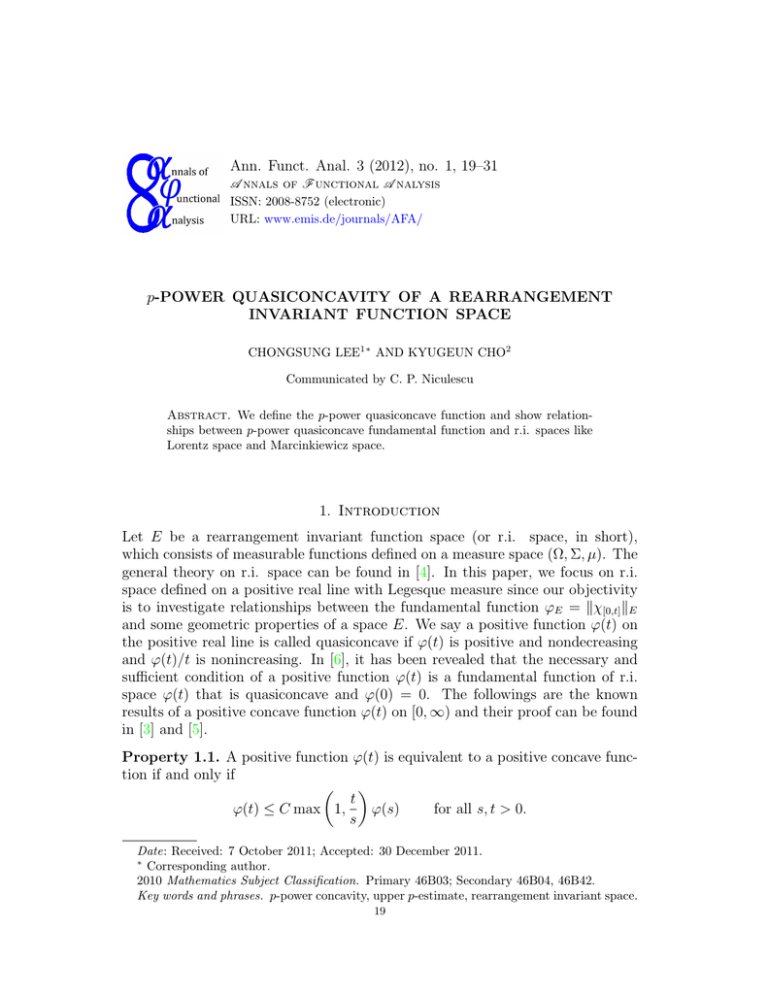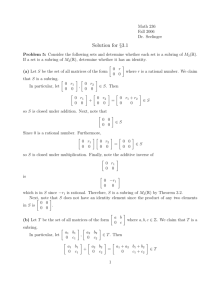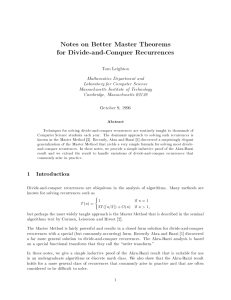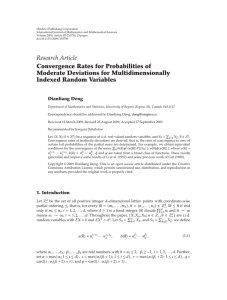Ann. Funct. Anal. 3 (2012), no. 1, 19–31 INVARIANT FUNCTION SPACE
advertisement

Ann. Funct. Anal. 3 (2012), no. 1, 19–31
A nnals of F unctional A nalysis
ISSN: 2008-8752 (electronic)
URL: www.emis.de/journals/AFA/
p-POWER QUASICONCAVITY OF A REARRANGEMENT
INVARIANT FUNCTION SPACE
CHONGSUNG LEE1∗ AND KYUGEUN CHO2
Communicated by C. P. Niculescu
Abstract. We define the p-power quasiconcave function and show relationships between p-power quasiconcave fundamental function and r.i. spaces like
Lorentz space and Marcinkiewicz space.
1. Introduction
Let E be a rearrangement invariant function space (or r.i. space, in short),
which consists of measurable functions defined on a measure space (Ω, Σ, µ). The
general theory on r.i. space can be found in [4]. In this paper, we focus on r.i.
space defined on a positive real line with Legesque measure since our objectivity
is to investigate relationships between the fundamental function ϕE = kχ[0,t] kE
and some geometric properties of a space E. We say a positive function ϕ(t) on
the positive real line is called quasiconcave if ϕ(t) is positive and nondecreasing
and ϕ(t)/t is nonincreasing. In [6], it has been revealed that the necessary and
sufficient condition of a positive function ϕ(t) is a fundamental function of r.i.
space ϕ(t) that is quasiconcave and ϕ(0) = 0. The followings are the known
results of a positive concave function ϕ(t) on [0, ∞) and their proof can be found
in [3] and [5].
Property 1.1. A positive function ϕ(t) is equivalent to a positive concave function if and only if
t
ϕ(t) ≤ C max 1,
ϕ(s)
for all s, t > 0.
s
Date: Received: 7 October 2011; Accepted: 30 December 2011.
∗
Corresponding author.
2010 Mathematics Subject Classification. Primary 46B03; Secondary 46B04, 46B42.
Key words and phrases. p-power concavity, upper p-estimate, rearrangement invariant space.
19
20
C. LEE, K. CHO
In particular, when C = 1, there exists a concave function ϕ(t)
e such that
1
ϕ(t)
e ≤ ϕ(t) ≤ ϕ(t).
e
2
Indeed, we can find a concave function which is equivalent to a given quasiconcave function.
Property 1.2. If ϕ(t) is positive and everywhere finite on (0, ∞), which satisfies
ϕ(t1 · t2 ) ≤ ϕ(t1 ) · ϕ(t2 ), then we get
log ϕ(t)
log ϕ(t)
= inf
=α
t→∞ log t
1<t log t
lim
and
log ϕ(t)
log ϕ(t)
= inf
=α
t<1 log t
t→0 log t
Furthermore, we have −∞ < α ≤ α < ∞.
lim
Definition 1.3. For a given positive, everywhere finite function ϕ(t) on (0, ∞),
we define the function Dϕ (s), which is called the dilation function of ϕ(t), by
ϕ(st)
.
0<t<∞ ϕ(t)
Dϕ (s) = sup
When ϕ(t) is quasiconcave, it is easy to show that Dϕ (s) is everywhere finite
and satisfies the submultiplicativity condition of Property 1.2. Therefore, we
can define the following two indices, which were introduced by Zippin for the
fundamental function ϕE (t) of r.i. space E (see [8]).
Definition 1.4. Let ϕ(t) be a positive quasiconcave function. We then define
two indices, r(ϕ) and r(ϕ), which will be called the upper and lower indices of
ϕ(t), by
log Dϕ (t)
log Dϕ (t)
= inf
r(ϕ) = lim
1<t
t→∞
log t
log t
and
log Dϕ (t)
log Dϕ (t)
r(ϕ) = lim
= sup
.
t→0
log t
log t
0<t<1
The following simple facts are also mentioned in [8] for the case of a fundamental
function ϕE (t) and [3].
Property 1.5. Let ϕ(t) be a quasiconcave function. We then have
i) 0 ≤ r(ϕ) ≤ r(ϕ) ≤ 1
ii) r(ϕ) + r(ϕ) = 1
iii) If Ψ(t) is equivalent to ϕ(t), then r(Ψ) = r(ϕ) and r(Ψ) = r(ϕ).
Property 1.6. Let ϕ(t) be nondecreasing and Dϕ (s1 ) ≤ s1 for some s1 > 1.
Then there exists a concave function Ψ(t) which is equivalent to ϕ(t).
p-POWER QUASICONCAVITY
21
2. p-Power quasiconcave function
Definition 2.1. Let ϕ(t) be a positive quasiconcave function on [0, ∞). We say
that ϕ(t) is p-power quasiconcave with a constant C if it satisfies
!
n
n
X
X
ϕp (ai ) ≤ Cϕp
ai ,
for all ai in [0, ∞).
(2.1)
i=1
i=1
In particular, if ϕ(t) is concave and satisfies (2.1), we say that ϕ(t) is p-power
concave with a constant C.
It is clear that the concave function x1/p is p-power concave. In the following, we
consider some conditions, which are useful in showing the existence of nontrivial
p-power quasiconcave functions.
Lemma 2.2.
i) If ϕ(t) is a p-power quasiconcave function with a constant
C, then ϕ(t) is also q-power quasiconcave with a constant C q/p when p ≤ q.
ii) Let ϕ(t) satisfy (2.1) and Ψ(t) be a positive nondecreasing function. Then
ϕ(t)Ψ(t) also satisfies (2.1).
iii) Let ϕ(t) be a positive p-power quasiconcave function on [0, ∞). If Ψ(t) is
equivalent to ϕ(t), then Ψ(t) also satisfies (2.1).
Proof.
i) It is clear since k · klp ≥ k · klq for p ≤ q. Indeed, we have
( n
)1/q ( n
)1/p
!
n
X
X
X
ϕq (ai )
≤
ϕp (ai )
≤ C 1/p ϕ
ai .
i=1
i=1
i=1
Hence,
n
X
n
X
ϕq (ai ) ≤ C q/p ϕq
i=1
!
ai
.
i=1
ii)
n
X
n
X
ϕp (ai )Ψp (ai ) ≤
i=1
!
n
X
ϕp (ai ) Ψp
i=1
n
X
p
≤ Cϕ
ai
i=1
n
X
!
p
ai
!
Ψ
i=1
!
ai
i=1
iii) Suppose that C1 ϕ(t) ≤ Ψ(t) ≤ C2 ϕ(t). Then,
n
X
i=1
Ψp (ai ) ≤
n
X
C2p ϕp (ai )
≤
C2p
· Cϕp
i=1
!
ai
i=1
≤ C·
n
X
C2
C1
p
Ψp
n
X
!
ai
.
i=1
22
C. LEE, K. CHO
Theorem 2.3. Let ϕ(t) be a positive quasiconcave function with r(ϕ) < 1 and
w(t) be a quasiconcave function. If Ψ(t) = ϕ(t)wα (t) for 0 ≤ α < 1 − r(ϕ), then
Ψ(t) is quasiconcave. Furthermore, if ϕ(t) is p-power quasiconcave, there exists a
concave function Φ(t) which is also p-power quasiconcave and equivalent to Ψ(t).
Proof. By Property 1.6, it is enough to show that Ψ(t) is nondecreasing and
DΨ (s1 ) ≤ s1 , for some s1 > 1. Since ϕ(t) and w(t) are quasiconcave and α is
nonnegative, Ψ(t) is nondecreasing. In order to show that DΨ (s1 ) ≤ s1 , for some
s1 > 1, take such that α + ≤ 1 − r(ϕ). With this , choose s1 sufficiently large
r(ϕ)+
from the definition of upper index of ϕ. Then, for all
such that Dϕ (s1 ) ≤ s1
t > 0,
Ψ(s1 t)
ϕ(s1 t){w(s1 t)}α
=
Ψ(t)
ϕ(t){w(t)}α
ϕ(s1 t){w(s1 t)/s1 t}α (s1 t)α
=
ϕ(t){w(t)/t}α tα
ϕ(s1 t) α
≤
s ,
ϕ(t) 1
since w(t)/t is nonincreasing and α is nonnegative,
≤ Dϕ (s1 )sα1
α+r(ϕ)+
≤ s1
≤ s1
since r(ϕ) + α + ≤ 1 and s1 ≥ 1. This implies that DΨ (s1 ) ≤ s1 for some s1 > 1.
Hence, Ψ(t) is quasiconcave and p-power quasiconcave by Lemma 2. 2. ii. The
existence of a concave function which is equivalent to Ψ(t) is also obtained by
Property 1.1
The above theorem tells us that for a given p-power quasiconcave function ϕ(t),
we can construct another p-power quasiconcave function which is nonequivalent
to ϕ(t). The next example is a p-power concave function which is not equivalent
to x1/p . The following concave function has 1/p as its lower and upper indices.
Thus, the converse of Property 1.5-iii) is not true.
Example 2.4. Let p > 1 be fixed. Define
(
1
0≤t≤1
ϕ(t) =
1 + log t 1 ≤ t
Define Ψ(t) = t1/p ϕ(t). We now compute the dilation function DΨ (s) of Ψ(t).
When s > 1, a simple calculation shows that
s1/p
0 < t ≤ 1/s
Ψ(st) 1/p
= s (1 + log st)
1/s < t ≤ 1
Ψ(t)
s1/p (1 + log st)/(1 + log t) 1 < t.
p-POWER QUASICONCAVITY
23
Therefore,
DΨ = sup {Ψ(st)/Ψ(t)}
0<t
=
sup s1/p (1 + log st) = s1/p (1 + log s).
1/s<t≤1
From this, we get
r(Ψ) =
lim log s1/p (1 + log s) / log s
s→∞
= 1/p + lim log{1 + log s}/ log s = 1/p
s→∞
Since 1/p is strictly less than 1 and Ψ(t) is nondecreasing, we take α such that
r(Ψ) = p1 < α ≤ 1. We then have DΨ (s) ≤ sα ≤ s for s > 1 hence there is a
concave function Ψ(t) by Property 1.6. When s ≤ 1, we get
s1/p
t≤1
Ψ(st) 1/p
= s (1 + log t)
1 < t ≤ 1/s
Ψ(t)
s1/p (1 + log st)/(1 + log t) 1/s < t.
Thus, by computation,
DΨ (s) = sup Ψ(st)/Ψ(t)
0<t
=
sup Ψ(st)/Ψ(t) = s1/p .
0<t≤1
Therefore, r(Ψ) = 1/p. Finally, Ψ(t) is not equivalent to t1/p since Ψ(t) is not
equivalent to t1/p . Also, Ψ(t) is p-power concave by Lemma 2.2.
Theorem 2.5. Let ϕ(t) be a p-power quasiconcave function with a constant C
and a lower index r(ϕ). Then, 1/r(ϕ) ≤ p.
Proof. By taking t for each ai in (2.1), we get
Dϕ (1/n) ≤ C 1/p (1/n)1/p .
Dividing both sides by log (1/n) < 0, we get
Dϕ (1/n)
(1/p) log C (1/p) log (1/n)
≥
+
.
log (1/n)
log (1/n)
log (1/n)
Letting n go to ∞, we have r(ψ) ≥ 1/p.
From this result, we know that if ϕ(t) is p-power quasiconcave, then we have p ≥ 1
by Property 1.5. We now consider conditions under which a given quasiconcave
function ϕ(t) is p-power quasiconcave.
Lemma 2.6. Let ϕ(t) be a positive quasiconcave function with r(ϕ) > 0. Then
there exists a constant 1 ≤ C and a positive quasiconcave differentiable function
Ψ(t) with Ψ(0) = 0 such that
ϕ(t) ≤ Ψ(t) ≤ Cϕ(t)
24
C. LEE, K. CHO
and
1 Ψ(t)
dΨ
Ψ(t)
≤
(t) ≤
.
C t
dt
t
Proof. Define Ψ(t) =
Rt
0
ϕ(x)
dx
x
x
.
ϕ(x)
Ψ(t)
is nonincreasing.
t
and let ϕ(x)
e
=
Ψ(t) is nondecreasing and we show that
t1 ≤ t2 ,
We have, for
Z
Ψ(t1 )
1 t1 ϕ(x)
=
dx
t1
t1 0
x
Z
1 t1 ϕ(t1 )
ϕ(t1 )
≥
dx =
.
t1 0
t1
t1
Thus,
Z
Ψ(t2 ) =
=
≤
≤
=
t2
ϕ(x)
dx
x
0
Z t2
Z t1
ϕ(x)
ϕ(x)
dx +
dx
x
x
t1
0
ϕ(t1 )
Ψ(t1 ) +
(t2 − t1 )
t1
Ψ(t1 )
Ψ(t1 ) +
(t2 − t1 )
t1
t2
Ψ(t1 ).
t1
Therefore, we have shown that Ψ(t) is qusiconcave. We now show that Ψ(t) is
equivalent to ϕ(t). Since r(ϕ) > 0, we know that r(ϕ)
e < 1 by Property 1.5. We
take α such that r(ϕ)
e < α < 1. By definition of r(ϕ),
e there exists M > 1 such
that
Dϕe(s) ≤ sα
for s > M .
Now, let t be fixed and let β = tM . If x is in (0, t) we have M < βx . Thus we get
ϕ(β)
e
≤ Dϕe
ϕ(x)
e
α
β
β
≤
x
x
and
ϕ(t)
e
≤ 1.
ϕ(β)
e
p-POWER QUASICONCAVITY
25
We then have
Z
Ψ(t) =
≤
=
=
=
t
1
1
ϕ(t)
e
dx =
·
e
ϕ(t)
e
ϕ(β)
e
0 ϕ(x)
Z β α
M
1
β
dx
ϕ(t)
e
x
0
1−α
βα 1
β
ϕ(t)
e 1−α M
β
1
1
· 1−α ·
1−α M
ϕ(t)
e
α
t
Mα
M
=
ϕ(t).
1 − α ϕ(t)
e
1−α
Z
0
t
ϕ(β)
e
dx
ϕ(x)
e
α
M
Now take C = 1−α
then we have the right inequality.
For the left inequality, the nonincreasing property of ϕ(t)
gives
t
t
=
ϕ(t) =
ϕ(t)
e
By definition of Ψ(t), we have
Z
0
dΨ(t)
dt
t
dx
≤
ϕ(t)
e
=
ϕ(t)
.
t
Z
0
t
dx
= Ψ(t).
ϕ(x)
e
Thus,
dΨ(t)
1
Ψ(t) ≤ ϕ(t) = t ·
≤ Ψ(t)
C
dt
and we get the result by dividing the above inequality by t.
Theorem 2.7. Let ϕ(t) be a quasiconcave function with r(ϕ) > 0. Then there
exists a finite p such that ϕ(t) becomes a p-power concave function.
Rt
Proof. By Lemma 2.2, it is enough to show that Ψ(t) = 0 ϕ(x)
dx satisfies (2.1)
x
p
since Ψ(t) is equivalent to ϕ(t) by Lemma 2.6. First, we want to show that Ψ t(t)
is nondecreasing for some finite p. Note that Ψ(t) is differentiable. We then have
d
dt
Ψp (t)
t
pΨp−1 (t)Ψ0 (t) · t − Ψp (t)
t2
Ψp−1 (t)
=
{pΨ0 (t) · t − Ψ(t)}
t2
Ψp−1 (t) pΨ(t)
≥
− Ψ(t)
t2
C
Ψp (t) p
=
−
1
.
t2
C
=
by Lemma 2.6
26
C. LEE, K. CHO
p p
Hence, for 1 ≤ C < p < ∞, dtd Ψ t(t) ≥ 0 and so Ψ t(t) is nondecreasing. We now
show that Ψ(t) satisfies (2.1).
!
(
!
)
n
n
n
n
.X
X
X
X
ai
=
ai Ψp
ai
ai
Ψp
i=1
i=1
≥
=
n
X
i=1
n
X
i=1
i=1
ai {Ψp (ai )/ai }
Ψp (ai ).
i=1
Theorem 2.8. Let ϕ(t) be the fundamental function of r.i. space E.
i) Suppose that ϕ(t) is p1 -power quasiconcave. If E satisfies an upper qestimate, then q ≤ p1 .
t
ii) Suppose that ϕ(t)
e = ϕ(t)
is equivalent to Ψ(t) which is p2 -power quasiconcave. If E satisfies a lower q estimate, then q ≥ pe2 where 1/p2 + 1/e
p2 = 1.
Proof.
i) Since ϕ(t) is p1 -power quasiconcave and the fundamental function
of r.i.-space, there exist constant C1 and C2 such that
1 1/p1
n
≤ ϕ(n) ≤ C2 n1/q
C1
for all integers n. Thus we have q ≤ p1 .
ii) Since ϕ(t)
e is equivalent to the p2 -power concave function, there exists C3
such that
1/p2
1
1
1
1
ϕ(
e )=
ϕ
≤ C3
.
n
n
n
n
By the lower q estimate property, we have C4 such that
1/q
1
1
ϕ( ) ≤ C4
.
n
n
Thus,
1−(1/p2 )
1/q
1 1
1
1
≤ϕ
≤ C4
C3 n
n
n
for all integers. Thus, we have 1/q ≤ 1 − (1/p2 ) = 1/pe2 .
3. Main result
We now apply the p-power quasiconcave property to some r.i. space like Lorentz
space and Marcinkiewicz space. Although there are several versions of these
spaces, we take Sharpley’s version with minor modifications [7]. Let f be a
real valued function defined on [0, ∞) with Lebegue measure µ. The distribution
function of f , denoted by λf (t), is defined by µ ({x : |f (x)| > t}). We define f ∗ (t)
p-POWER QUASICONCAVITY
27
is the non-increasing,
right continuous function which is equimeasurable with f
R
1 t ∗
∗∗
and f (t) = t 0 f (x)dx.
For an explicit formula of f ∗ (t), we have f ∗ (t) = inf{y ≥ 0 : λf (y) ≤ t} [1].
Definition 3.1. Let ϕ(t) be a quasiconcave function on [0, ∞) with 0 < r(ψ) ≤
r(ψ) < 1 and 1 ≤ q < ∞.
The Lorentz space Λψ,q is the set of all measurable functions f such that f ∗
exists and
Z ∞
1/q
q dt
∗∗
kf kΛψ,q =
(f (t)ψ(t))
< ∞.
t
0
The Marcinkiewicz space Mψ is the set of all measurable functions f such that
kf kMψ = sup ψ(t)f ∗∗ (t) < ∞.
t>0
By definition, we can easily show that kf kΛϕ,q and kf kMϕ are equivalent to
kf kΛψ,q and kf kMψ respectively when ϕ and ψ are equivalent. It is well known
Rt
R
that 0 f ∗ (x)dx = supµ(E)=t A |f |dx (See page 64 in [3]). Thus we have an
alternate form of kf kMϕ :
Z
ψ(µ(E))
kf kMψ = sup
|f |dµ.
µ(E)>0 µ(E)
A
For the space Λψ,q , we have also useful form of its norm
Z ∞
1/q
q dt
∗
∗
[f (t)ψ(t)]
kf kΛψ,q =
,
t
0
which is equivalent to kf kΛψ,q (see [7, Theorem 2.3]).
We now introduce some functional which is convenient to compute the norm
in ΛΨ,q . We modify the proof in Sharpley’s version of Lorentz space (see [3, 7]).
Lemma 3.2. i) Let f be an element in Λψ,q . Then, the functional
Z ∞
1/q
q
∗
q
0
kf kΛψ,q =
((f (t)) dψ
0
is equivalent to kf kΛψ,q .
ii) The fundamental function ϕΛψ,q in Λψ,q is equivalent to ψ(t).
iii) If f ∈ Λψ,q , we have
Z ∞
1/q
0
q−1
q
kf kΛψ,q = q
y [ψ (λf (y)] dy
.
0
Proof.
i) By Lemma2.6,
R t ψ(t) has an equivalent quasiconcave differentiable
function Ψ(t) = 0 ψx dx and we can renorm Λψ,q by replacing ψ(t) with
Ψ(t). Thus we may assume, for some constant C,
dψ
ψ(t)
1 ψ(t)
≤
(t) ≤
.
C t
dt
t
28
C. LEE, K. CHO
Then, by the improper Stieltjes integral, we have
Z ∞
n
oq
0
∗
q
(f ∗ (t))q dψ q ,
kf kΛψ,q
= ψ(+0)(f (+0)) +
+0
since 0 < r(ψ), it is easy to get lim ψ(s) = 0,
s→0
Z ∞
dψ(t) dt
(f ∗ (t))q qψ q−1 (t)
=
t .
dt
t
0
Since
q q
ψ (t)
C
≤ qψ q−1 ·
dψ(t)
dt
· t ≤ qψ q (t), we have
q
kf k∗Λψ,q ≤ kf k0Λψ,q ≤ qkf k∗Λψ,q .
C
Thus kf k0ψΛ,q is equivalent to kf kΛψ,q .
o1/q
nR
t
= ψ(t), the fundamental function ϕΛψ,q is
ii) Since kχ[0,t] k0Λψ,q = 0 dψ q
equivalent to ψ(t).
iii) Since simple functions are dense
Pn in Λψ,q (see [2, 7]), we show the result
for a simple function f = i=1 ai χAi , where {Ai } are pairwise disjoint
measurable sets.
Pi Without loss of generality, we may assume a1 > · · · > an .
Define di = j=1 µ(Ai ) and d0 = 0. Then, we have
(
di ai+1 ≤ y < ai
λf (y) =
0 a1 ≤ y
Hence,
kf k0Λψ,q
Z
∞
∗
q
(f (t)) dψ
=
q
1/q
0
=
( n
X
)1/q
aqi [ψ q (di ) − ψ q (di−1 )0]
i=1
On the other hand,
Z ∞
1/q
q
q−1
q
y {ψ[λf (y)]} dy
0
1/q
= ψ q (dn )aqn + ψ q (dn−1 )(aqn−1 − aqn ) + · · · + ψ q (d1 )(aq1 − aq2 )
!1/q
n
X
q
=
a1 [ψ q (di ) − ψ q (di−1 )]
=
i=1
kf k0Λψ,q
Theorem 3.3. If ψ(t) is p-power quasiconcave with constant C, the space Λψ,q
satisfies a lower-p-estimate for 1 ≤ q < p.
p-POWER QUASICONCAVITY
29
Proof. Since a lower estimate is metric invariant, we use the equivalent functional
kf k0Λψ,q by Lemma 3.2. Let {fi } be elements in Λψ,q with pairwise disjoint support.
P
P
Note that ni=1 λfi (y) = λ ni=1 fi (y).
By Lemma 3.2, we have
( n
X
kfi k0Λψ,q
p
)1/p
=
n Z
X
i=1
ψ q (λfi (y))dy q
n Z
X
Z
∞
p
q/p q
ψ (λfi (y)
dy
∞
≤
( n
X
0
ψ p (λfi (y)
n
X
kfi kLr
i=1
Z
1/q
)q/p
dy q
i=1
since
p/q !1/p
0
i=1
p/q !1/p
0
i=1
=
∞
∞
i=1
(
"
Cψ p
≤
n
X
≤
fi 0
n
X
when r < 1
Lr
1/q
#)q/p
λfi (y)
dy q
i=1
since ψ is p-power quasiconcave
#)q
!1/q
Z ∞ ( "X
n
= C 1/p
ψ
λfi (y)
dy q
0
Z
i=1
∞
q q
= C
ψ λPni=1 fi (y)
dy
0
0
n
X
= C 1/p fi 1/p
i=1
1/q
Λψ,q
e = t is q-power quasiTheorem 3.4. Let ψ(t) be quasiconcave such that ψ(t)
ψ(t)
concave with constant C. Then Mψ satisfies an upper p-estimate where p1 + 1q = 1.
n
Proof. Let {fi }ni=1 be a set of measurable functions with disjoint supports
T {Ei }i=1
respectively. Let E be any measurable set in [0, ∞). Define Fi = A Ei . Since
30
C. LEE, K. CHO
P
each Ei ’s are disjoint, we know ni=1 µ(Fi ) ≤ µ(E). Thus
Z X
m
m Z
ψ(µ(E))
ψ(µ(E)) X
fi =
fi
µ(E)
µ(E) i=1 E
E i=1
ψ(µ(E)) X µ(Fi )
kfi kMψ
≤
µ(E)
ψ (µ(Fi ))
( n )1/p
q )1/q (X
m
ψ (µ(E)) X
µ(Fi )
≤
kfi kpMψ
µ(E)
ψ
(µ(F
))
i
i=1
i=1
)1/p
( n
!q )1/q ( m
m
X
ψ (µ(E)) X e X
ψ
µ(Fi )
kfi kpMψ
≤
µ(E)
i=1
i=1
i=1
( n
!) ( n
)1/p
m
X
ψ (µ(E)) X e X
p
=
ψ
µ(Fi )
kfi kMψ
µ(E)
i=1
i=1
i=1
( n
)1/p
Pn
X
µ(F
)
ψ (µ(E))
i
p
Pi=1
kfi kMψ
= C
µ(E) ψ ( ni=1 µ(Fi )) i=1
( n
)1/p
X
≤ C
kfi kpMψ
,
i=1
ψ(t)
t
since
is nonincreasing and
We thus have
n
X
f
i
i=1
Pn
i=1
µ(Fi ) ≤ µ(E).
≤C
Mpsi
( n
X
)1/p
kfi kpMψ
.
i=1
The following are easily obtained from the above theorems.
Corollary 3.5. Weak Lp satisfies an upper p-estimate.
Corollary 3.6. Let ψ(t) be a quasiconcave with r(ψ) < 1. Then there exists p
such that 1 < p < ∞ and Mψ satisfies an upper p-estimate.
Acknowledgement. This work was supported by the Inha University Research Grant.
References
1. M. Cwikel, The dual of weak Lp , Ann. Inst. Fourier, Grenoble 25 (1975), 81–126
2. R.A. Hunt, On Lp,q spaces, Enseignement Math. 12 (1966), 249–276.
3. S. Krein, J. Petunim and E. Semenov, Interpolation of linear operators, English transl.,
Transl. Math. Mono. vol 54, AMS Providence, R.I. 1980
p-POWER QUASICONCAVITY
31
4. J. Lindenstrauss and L. Tzafriri, Classical Banach Spaces II, Function Spaces, Ergeb. der
Math. u. ihr. Grenzgeb, 97, Berlin, Springer, 1979
5. J. Peetree, Concave majorants of positive functions, Acta. Math. Acad. Sci. Hunger 21
(1970), 327–333
6. E.M. Semenov, Embedding theorems for Banach spaces of measurable functions (Russian),
Dokl. Akad. Nauk SSSR 156 (1964), 1292–1295.
7. R. Sharpley, Spaces Λα (X) and interpolation, J. Functional Analysis 11 (1972), 479–513
8. M. Zippin, Interpolation of operators of weak type between rearrangement invariant function
spaces, J. Funct. Anal. 7 (1971), 267–284
1
Department of Mathematics Education, Inha University, Inchon 402-751, Korea.
E-mail address: cslee@inha.ac.kr
2
Bangmok College of General Education, Myong Ji University, Yong-In 449728, Korea.
E-mail address: kgjo@mju.ac.kr





